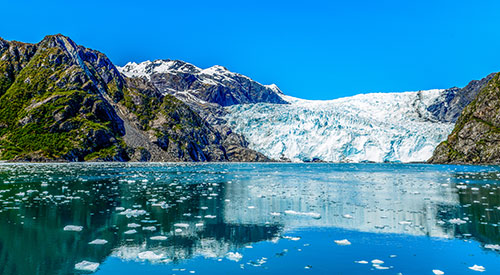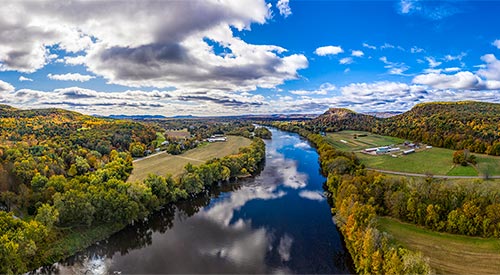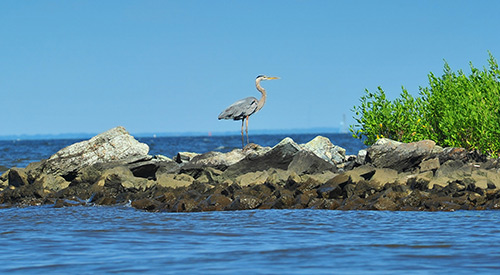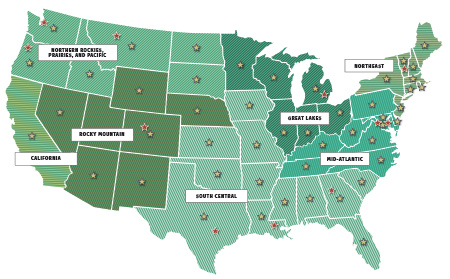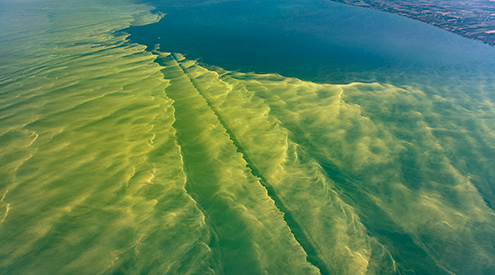 Climate change is one of the biggest threats to human communities and the long-term survival of America’s wildlife. Impacts include worsening megafires and hurricanes; harmful algal outbreaks; habitat loss; the spread of disease, pests, and invasive species; and a host of other dangerous conditions for people and wildlife. The climate science is clear—the world must slash greenhouse gas emissions in half by 2030, and reach net zero emissions by 2050. As such, we need practical policy solutions that will mitigate the impacts of climate change by quickly cutting and capturing carbon pollution and ensuring we are able to adapt to the impacts we cannot avoid.
Climate change is one of the biggest threats to human communities and the long-term survival of America’s wildlife. Impacts include worsening megafires and hurricanes; harmful algal outbreaks; habitat loss; the spread of disease, pests, and invasive species; and a host of other dangerous conditions for people and wildlife. The climate science is clear—the world must slash greenhouse gas emissions in half by 2030, and reach net zero emissions by 2050. As such, we need practical policy solutions that will mitigate the impacts of climate change by quickly cutting and capturing carbon pollution and ensuring we are able to adapt to the impacts we cannot avoid.
Below are policies that the U.S. government must take in order to confront the growing threat of climate change.
Climate Mitigation: Moving Toward a Net Zero Carbon Economy
As of April 2019, 78 carbon pricing schemes are already in place or are scheduled for implementation throughout the world at the national or subnational levels. Ten U.S. states have also priced carbon pollution, seeing it as an efficient way to speed the transition to a lower carbon economy while earning revenues and boosting economic activity.
Two primary pricing policies include a carbon tax, which would establish a specific fee—ideally at an increasing rate over time—to discourage high-carbon activities, and a cap-and-trade program, which would auction off a declining number of pollution permits over time, thereby driving up the cost of available permits, and incentivizing lower carbon activities. A carefully designed federal carbon price could be constructed to drive significant pollution reductions while protecting and improving conditions for vulnerable communities and wildlife, and ensure an equitable transition to the net zero carbon economy.
Market-based features can also be included in transformative policies such as a clean energy standard or renewable portfolio standard, which could require power companies to generate an increasing amount of zero-carbon emitting energy over time, and offer credits for such generation that can be traded. The market may set a price for the clean power credits depending on demand, thereby indirectly pricing carbon pollution.
We must shift investment away from conventional fossil fuels towards a net zero carbon economy and infrastructure, in a way that helps workers and communities harness new opportunities and adapt to new workforce needs, while cleaning up the legacy of a polluting past. To achieve this, we must invest in clean energy and transportation, energy efficiency, and energy storage so that all people may benefit, including disadvantaged communities, plus include local workers and economies in reclamation and restoration efforts that enhance carbon sequestration opportunities while improving air and water quality. The following policies would support this transition:
- Federal and state adoption of clean energy standards to drive demand.
- Tax credits for non-emitting energy sources to help level the playing field with subsidized fossil fuels.
- Grants to facilitate low-income and rural use of clean energy and energy efficiency.
- Improved transmission policies to ready the nation’s power grid to accommodate more clean energy sources.
- Robust investment in clean energy research and development, energy storage, and carbon capture, use, and storage strategies – both technological and natural.
- Inclusion of natural features and strategies in infrastructure investments to harness the resilience-building power of nature to protect people and wildlife.
Congress should also ensure the U.S. continues to develop its vast renewable resources wisely by keeping strong bedrock conservation protections in place while supporting federal permitting and leasing processes that are efficient, environmentally responsible, and direct development to low impact areas. The nation’s first-ever offshore wind project in Rhode Island provides an excellent example.
According to a recent report by the Rhodium Group, even with investments in clean energy and energy efficiency, the U.S. will need to pull between 185 and 1850 million metric tons of CO2 per year from the atmosphere by 2050 in order to meet its climate goals. Scaling up natural and technology-driven carbon sequestration will take significant investment, but the alternative worsening impacts of climate change will cost far more.
Today, U.S. forests, grasslands, and soils offset approximately 15 percent of all U.S. fossil fuel related emissions each year (equal to half of all transportation emissions). A significant opportunity exists to expand policy measures to increase the carbon storage capacity of our lands and forests. These strategies can generally be implemented in the near-term and cost-effectively, and can generate significant economic opportunity.
Natural carbon sequestration measures can include:
- Tailoring existing federal policies that promote forest management, agriculture, and other land use for ecologically-appropriate carbon storage and climate resilience.
- Incentivizing reforestation that is good for ecosystems and wildlife.
- Reducing the risk of forest, wetland, and grassland conversion to development.
Carbon capture, utilization, and storage (CCUS) as well as carbon dioxide removal (CDR) technology will be a necessary complements to natural sequestration measures, especially in the industrial sector where other emission reduction strategies are difficult. CCUS technologies can significantly decrease the amount of carbon dioxide entering the atmosphere from industrial facilities through capture and storage or reuse of carbon. A subset of these technologies – direct air capture (DAC) – deploys large machines that run on clean or carbon captured energy to pull carbon from the air for storage or reuse. Some of these methods are being test-driven in the oil and gas sector today, though significant investment is needed to apply technologies to the industrial sector, bring direct air capture to scale, and spur markets for products using captured carbon.
Current law gives the federal government clear authority to protect the public health and welfare from carbon pollution and climate change. Sensible measures were put in place in the Obama Administration to reduce this pollution and related risks to wildlife and people, such as the Clean Power Plan, oil and gas industry methane standards, and fuel economy rules for cars and trucks. Yet, the current administration is undoing this progress.
The next administration should immediately work to restore policies to cut emissions in the electricity, oil and gas, and transportation sectors, while working with Congress to greatly expand upon these. Scientific understanding of the climate crisis has only grown more certain and alarming, and the urgency and significance of required steps are clearer than ever. The executive actions of a new administration, albeit essential, will not be sufficient in scope or speed to mobilize the pollution reductions needed. Congress must step up to begin implementing the measures above, as well as work with a new administration on major legislation such as a carbon price.

Climate Adaptation
Understanding climate-related vulnerabilities to natural resources and human communities is key to designing effective adaptation strategies to reduce those risks. Preparing for projected climate changes and related impacts will be increasingly important, and climate adaptation should be integrated into planning at all levels of government—local, state, and federal. Proactive adaptation and resilience actions can significantly reduce the impact of hurricanes, storms, drought, and other climate-related threats.
Natural ecosystems, such as wetlands, dunes, and forests, can buffer the impact of storms, floods, and other extreme weather events on local communities. Unfortunately, the loss or degradation of natural habitats has increased the climate-risks to many communities. Protecting and restoring natural systems can be a cost-effective means of protecting people and property, and these natural solutions have the added benefit of being capable, in many cases, of self-repairing after storm or flood damage or keeping pace with rising sea levels. In contrast to hard infrastructure, nature-based solutions also can provide benefits for wildlife habitat, water quality, and recreation.
Climate-related impacts are undermining the health of the nation’s forests, rangelands, and water supplies. Adopting and applying the principles of climate-smart conservation can help natural resource managers ensure that our lands and waters continue supporting the needs of both people and wildlife. Federal and state management policies should be modified to take future, rather than past, climate conditions into account, and to prioritize resilience and long-term sustainability. Policies for land and water management should also strive to enhance the capacity of these systems to sequester and store carbon, but do so in ways that also maintain and restore wildlife habitat.
A changing climate will result in unprecedented ecological changes, including shifting ranges for many wildlife species. Habitat corridors already are essential for migratory animals and the natural dispersal of flora and fauna, but these linkages will become even more significant in a warming world. Enhancing and restoring habitat corridors and landscape connectivity will be key to helping wildlife species track suitable climatic conditions. Additionally, climate-related threats, such as sea level rise, will dramatically affect many coastal habitats, such as wetlands. In the face of rising seas, these wetlands will only be capable of shifting inland if there is adjacent undeveloped open space.
As climate change amplifies the frequency, severity, and extent of storms, floods, wildfires, and other natural hazards, increasing numbers of existing homes and businesses will be impacted. Discouraging new development in risky locations will be key to reducing future impacts of climate change. Development in floodplains, forests, and other risky areas often fragments and degrades the capacity of natural systems to absorb floodwaters and provide other protective benefits to adjacent communities. Discouraging development in hazardous areas will rely on accurate and up-to-date risk maps, which take future climatic conditions into account. Policies should be adopted at local, state, and federal levels that remove subsidies or incentives for building in environmentally sensitive areas, and instead encourage development in areas with lower natural hazard risks.
The National Flood Insurance Program (NFIP) should be reformed to curb the use of taxpayer dollars to subsidize and promote development and re-development in environmentally sensitive and risky places in coastal areas and floodplains. The program should move toward risk-based rates for all properties, with means-tested assistance for those who cannot afford actuarial rates. Communities that engage in pro-active hazard mitigation efforts should be rewarded with preferential flood insurance rates. Similarly, federal disaster response programs should emphasize more pre-disaster planning and risk mitigation. By significantly increasing investment in proactive hazard mitigation, the federal government could greatly reduce future impacts and disaster costs. The federal government should also reinstate the Federal Flood Risk Management Standard, which creates common-sense rules to help protect communities and federal investments from future floods.
All policies should ensure that the benefits of resilience and adaptation efforts are justly distributed across society. Low income, minority, and other historically underserved populations often are on the front lines of the impacts of climate change and sea-level rise, and can be made even more vulnerable by poverty, linguistic isolation, and poor infrastructure.
The ability of society to prepare for and adapt to changing climatic conditions depends on reliable scientific information. Effective adaptation requires an understanding of how the climate is, or may be, changing, the potential impacts of those changes for people, ecosystems, and wildlife, and an understanding of how various strategies may be capable of reducing those impacts or risks. Unfortunately, climate science is under attack at the federal level, through efforts to defund important scientific programs, reduce access to existing information, and limit the role of science and scientists in the formulation of public policies and regulations. There is an urgent need to reverse these anti-science policies, and adopt or reinstate policies that assure scientific integrity and a reliance on science-based facts in policies and regulations.
Climate-Smart Infrastructure: A down payment for a resilient and low-carbon economy
Smart investments in our nation’s energy, industrial, transportation, water, and natural infrastructure systems can increase community safety and resilience, protect and recover wildlife, boost local economies and family-sustaining jobs, and reduce greenhouse gas emissions. Effectively addressing our infrastructure needs also requires maintaining the full suite of protections provided by the nation’s environmental laws, including the National Environmental Policy Act, Clean Water Act, Clean Air Act, Endangered Species Act, Safe Drinking Water Act, and more. Further, lasting, broad support for infrastructure investments requires improving equitable access to benefits, and ensuring the health and safety of the most vulnerable people and the environment. Learn more >>
